Itinerary: University buildings
For your Itinerary this month, supported by Dulux Colours of New Zealand, Andrew Barrie and Julia Gatley look at boundary-pushing educational buildings across the country from Dunedin to Waikato, Auckland and more.
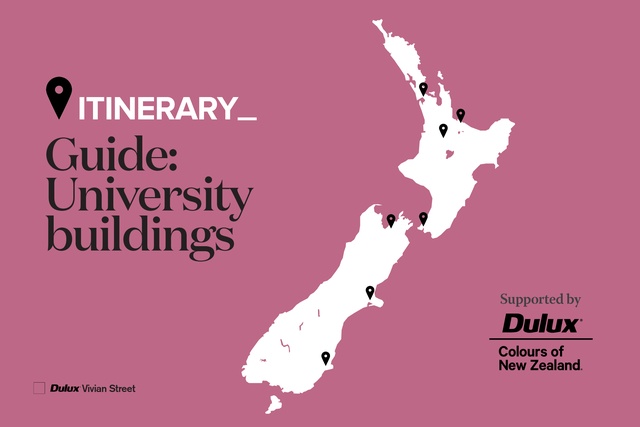
Perhaps reflecting their origin in the monastic tradition, university buildings are typological hybrids – part workaday educational buildings, part grand civic institutions.
The early days of local universities produced palaces of learning, such as Maxwell Bury’s Registry Building at the University of Otago (1878) and Lippincott and Billson’s ClockTower at the University of Auckland (1926). With the massive post-war expansion of universities, which resulted in much of our current campus architecture, things became more serious. Like much civic architecture of the time, value was placed on design that was robust, direct and filled the needs of as many people as possible. A focus on standardisation, repetition and combinations of off-form and pre-cast concrete delivered brutalism that was sometimes dramatic, sometimes dour. By the 1980s and 1990s, we were all over the show – Warren and Mahoney created a campus for Massey University in Albany that was a swathe of Palo Alto PoMo (mid-1990s) but, across town, JASMaD was completing Waipapa Marae (1988) at Auckland and Rewi Thompson was creating a radical building for Unitec’s Māori Studies department (1993).
Changes in the structure of the tertiary education sector in the 1990s triggered more intense competition between institutions. Architecture again became part of the way universities differentiated themselves – the way they branded. In place of the stolid post-war slabs, we had visual drama and spatial porosity. Particularly in recent years, almost all big university buildings have been arranged around dramatic atria and voids. Lounges took the place of courtyards. This new openness might be explained by new teaching modes that emphasise interactivity and engagement. Contrarily, though, most of our new buildings still keep staff and students apart, sometimes in plan zones but, most often, by placing the staff in towers and the students in basements – no doubt following sound functional and structural logics but the symbolism is unfortunate. Further, rather than having individual offices lined with personal books and accumulated teaching resources, academics are now being placed in open-plan ‘cube farms’. They say don’t trust a skinny chef. How about a scholar with no books?
There’s likely to be a pendulum swinging here, between two of the key streams of Greek philosophy – Stoicism and Epicureanism. The Stoics sought understanding of the world as the path to virtue; for them, wisdom brought indifference to material conditions and an emphasis on virtuous behaviour. For the Epicureans, knowledge was the route to pleasure or, at least, to the avoidance of pain and fear; for them, sensation was critical and the benefit of understanding was that it brought tranquillity. We currently seem to be accelerating towards the Epicurean pole, which manifests as a huge emphasis on ‘the student experience’. Alternatively, it could be management wanting cool backdrops for their websites and student Instagram shots.
New Zealand universities have a history as major patrons of architecture. They used to put their trust in young firms. Most of today’s highest-profile firms received important tertiary commissions in their early years: Warren and Mahoney produced student unions and other buildings for Massey University and the Universities of Canterbury and Auckland in the 1960s; one of JASMaD’s most significant early projects was for Auckland; and Architectus’ first big building was for Canterbury. The trust generally resulted in very good buildings. But the tertiary plum jobs are still mostly being hoovered up by the same folk. This might be to do with increased value being placed on relationships and track record. A less optimistic explanation would be that astute selection has been replaced by risk aversion. Of course, these commissions are still resulting in award-winning work but it raises the question of what younger firms might achieve with the interesting briefs and healthy budgets these projects tend to offer.
THE ITINERARY
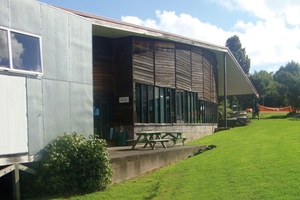
01. 1993 – Puukenga
Carrington Road, Mount Albert, Auckland, by Rewi Thompson with Southcombe McClean
Puukenga initially served as the home of Unitec’s Māori Studies programme. It consists of a series of metal-clad teaching pods plugged into a large whare form that contains common space and administration facilities. Created from a palette of raw materials, the building unfolds as a complex narrative, involving an internal watercourse, carved structural elements and lights arranged in the patterns of constellations. The building won an NZIA Branch Award in 1995. See Architecture NZ May/June 1992 and Mar/Apr 1994. While you’re here, pop next door to the wharenui Ngākau Māhaki (2009), designed and built by Te Arawa master carver Dr Lyonel Grant (Ngāti Pikiao).
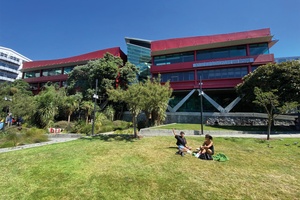
02. 1994 – Schools of Architecture and Design
139 Vivian Street, Wellington, by Craig, Craig, Moller Architects
The VUW School of Architecture used to occupy a series of old houses in Kelburn. The move to Vivian Street enabled it to join forces with part of the Wellington Polytechnic School of Design. Air New Zealand’s 1970s’ freight building was adapted to accommodate them both. It was big enough to allow an atrium in the middle, ringed by lecture theatres, a library, administration facilities and meeting rooms, with a generous workshop in the basement and studios upstairs. The exterior was painted red in reference to the location in Wellington’s then well-known red-light zone. The ground floor has been renovated by Architectus in recent years. See Architecture NZ May/June 1994.
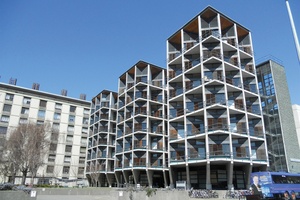
03. 1998 – Erskine Building
Science Road, Ilam, Christchurch, by Architectus with CHS and Royal Associates Architects
Built to house the University of Canterbury’s departments of Mathematics, Statistics and Computer Sciences, this project was conceived as three distinct and differently expressed zones: a strip of teaching spaces; academic offices in three vertiginous towers; and a dramatic linear atrium allowing movement between them. The academic offices were configured as stacks of double-height pods to encourage interaction between staff. Aussie architectural critic Rory Spence wrote, “it is architecturally dramatic and seductive yet it is also socially responsive to its users”. Architectus was awarded the project through a competition and it marked the firm’s stepping up from residential to institutional-scale work. See Architecture NZ Sept/Oct 1998.
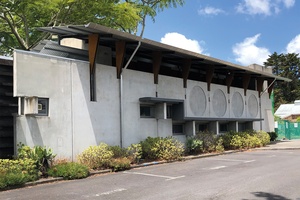
04. 2002 – Landscape and Plant Sciences Building
Carrington Road, Mount Albert, Auckland, by Mitchell & Stout Architects
Merging the patterns of the cloistered courtyard and the Kiwi verandah, this two-storeyed building for Unitec comprises a series of staff offices around a planted courtyard. Produced with a relatively low budget, this gem of a building was constructed from exposed pre-cast concrete panels, combined with plywood, timber and galvanised steel. The project received an NZIA New Zealand Award in 2005, the citation reading: “An intimate arrangement of offices and ancillary spaces is used to form a courtyard which reinterprets the Oxbridge model of tertiary buildings in a delightfully informal and contemporary South Pacific way.” The building is currently empty and its future is uncertain. See Architecture NZ Jan/Feb 2004.
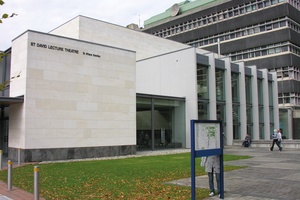
05. 2002 – St David Lecture Theatre
St David Street, Dunedin, by McCoy Wixon Architects
McCoy Wixon produced numerous important educational buildings – the NZIA’s premier award for educational architecture is named for Ted McCoy – and those at the University of Otago include University College (1969), the Archway Lecture Theatres (1973), the Richardson Building (1979) and the Castle Theatres (1988). The St David Lecture Theatre, with one frontage to a busy street and another to the main pedestrian route through the campus, occupies a plum site looking across the Leith to Maxwell Bury’s 1878 Registry Building. It contains a very large lecture theatre as well as smaller teaching spaces, a café, a free-flowing lobby and study spaces. See Architecture NZ May/June 2002.
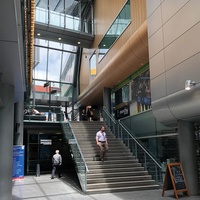
06. 2003 – Kate Edger Information Commons
9 Symonds Street, Auckland, by Warren and Mahoney
Built alongside Warren and Mahoney’s 1960s’ University of Auckland Student Union building, this complex combines student services – cafés, shops, health and counselling services – and study facilities. When the project won an NZIA Resene New Zealand Award in 2005, the citation read: “A bravura collision of sophisticated forms creates an innovative new form of student support facility. The resultant assemblage organises a complex built context and takes advantage of existing topography and streetscape to form a variety of social and study spaces.” The project also received an NZIA Resene Local Award in 2003 and a Property Council Merit Award in 2004. See Architecture NZ July/Aug 2003 and Nov/Dec 2007.
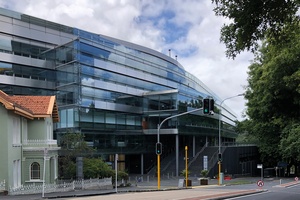
07. 2008 – Sir Owen G Glenn Building
12 Grafton Road, Auckland, by FJMT with Archimedia
This project resulted from a competition, which involved several of New Zealand’s largest firms and which sought “a distinctive and memorable Business School building – an icon” for the University of Auckland. It was supported by a $7.5m philanthropic donation: at the time, New Zealand’s largest-ever private donation to education. The opening of the building became mainstream news when, because of a high-profile political donations controversy, Helen Clark was desperate to avoid being photographed with Owen Glenn. Marking the edge of the campus, the exterior is dramatic but the planning has not been without its critics – for a thoughtful analysis, see Bill McKay in Architecture NZ Jan/Feb 2008.
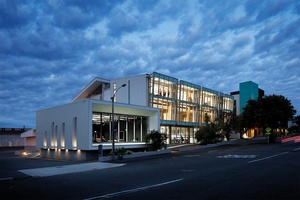
08. 2010 – NMIT Arts and Media Building
61 Nile Street, Nelson, by Irving Smith Jack Architects
Containing a range of studio, teaching and staff spaces, all arranged around a central atrium, this building is best known as a landmark in the development of timber structure, winning a long string of national and international awards. The project received special government funding to support the use of timber. It parleyed this into a world-first seismic solution, which used post-tensioned timber shear walls. It achieved the remarkable sustainability feat of having all its structural components grown, milled and fabricated within 80km of the construction site. The timber goes a long way to softening the typical institutional feeling of university buildings. See Architecture NZ May/June 2011.
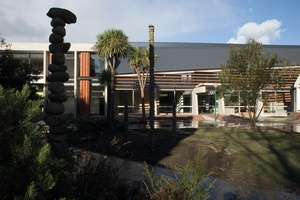
09. 2009 – Landscape Architecture Building
Farm Road, Lincoln, Canterbury, by Sheppard & Rout Architects with Royal Associates Architects
This low-rise structure is arranged along a generous, double-height ‘internal street’, interconnecting the two floors of studio areas and teaching spaces, and promoting interaction and informal learning. The design palette of unfinished materials and exposed structure, combined with the intimate scale of the building, creates a delightfully calm and understated environment. The NZIA awarded the project a Local Award in 2009 and a New Zealand Award in 2010. See Architecture NZ May/June 2010. While on the Lincoln Campus, Sheppard & Rout fans might also like to visit the firm’s James Stewart Building (1993) and Te Kete Ika dining hall (2014).
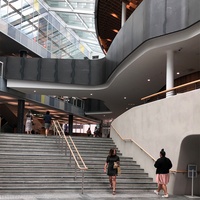
10. 2013 – Sir Paul Reeves Building
2 Governor Fitzroy Place, Auckland, by Jasmax
AUT has kept up an almost continuous programme of building since the late 1990s, when it began its transition to university status, and Jasmax has maintained an enduring relationship across those years. This multi-award-winning complex, the centrepiece of AUT’s city campus, is a 12-storeyed office and classroom building floating over an airy lobby space, which not only gives access to the lecture theatres and teaching spaces but connects to adjacent buildings, the street and surrounding open spaces. See Architecture NZ Sept/Oct 2013. Across the laneway is Jasmax’s NZIA Supreme Award-winning Business School (2005) and, to the west, is its Richard Meier-esque Hotel and Restaurant Studies Building (1997).
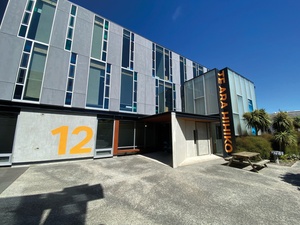
11. 2011–2012 – Te Ara Hihiko College of Creative Arts
Wallace Street, Wellington, by Athfield Architects
Massey University won the contract to take over the old Wellington Polytechnic School of Design. The Wallace Street building houses the parts of the college not accommodated in the former Dominion Museum and National Art Gallery building. It is another landmark in timber – the world’s first to use a post-tensioned laminated veneer lumber (LVL) frame in a multi-storeyed building. The frame is expressed internally, complemented by carvings by Jacob Scott. The stepped building also improves circulation across the campus, at three different levels. It earned NZIA New Zealand Education Architecture and Sustainability Awards in 2014. See Architecture NZ July/Aug 2012 and May/June 2014.
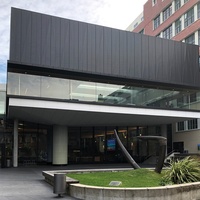
12. 2010–2013 – Campus Hub and Library
Kelburn Parade, Wellington, by Athfield Architects with Architectus
The quad in the middle of VUW’s Kelburn Campus used to be a wet and windswept place. Athfield Architects’ glass roof was a major step forward in the mid-1980s but that was nothing compared with the Hub project, which transformed the whole area into what is now, perhaps, the most luxurious hang-out space on any of New Zealand’s tertiary campuses. It has become an interior rather than exterior space, linking multiple buildings around it, including the main library, with cafés, couches and WiFi for those who like to take their laptops out in public. A new library reading room hovers above. It earned an NZIA New Zealand Education Architecture Award in 2014. See Architecture NZ May/June 2014.
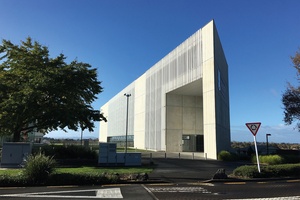
13. 2017 – Law and Management Building
Hillcrest Road, Hamilton, by Opus
Standing on the edge of the University of Waikato campus, this sculptural project makes the most of its hillside location. It is composed as a stern concrete shard of staff offices, rising dramatically into the sky, and teaching spaces excavated into the ground. The zones are linked by an internal processional route that follows the slope of the hillside and displays the history of the university. The teaching and gathering spaces are arranged around sunken courtyards – the architects have shunned the typical Koru Lounge vibe of new university buildings, opting instead for stripped-back clarity and calm. See Architecture NZ Jan/Feb 2018.
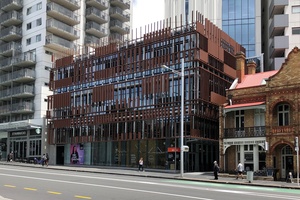
14. 2018 – Ngā Wai Hono
31 Symonds Street, Auckland, by Jasmax
Tucked behind a screen of distinctive chocolate-coloured louvres, this AUT building snakes between two street frontages and links into adjacent buildings, stitching together a complex set of functions and spaces. Including welcoming spaces for public use – a café and exhibition zone – as well as light-filled student areas, it’s one of a new breed of university buildings that places teaching staff in cubicles rather than individual offices. Where do their books go? The building received the NZIA’s Ted McCoy Award for Education Architecture in 2019. See Architecture NZ Nov/Dec 2019. Check out Jasmax’s nearby AUT Te Amorangi library and administration complex (2001) and the AUT Art and Design Building (2004).
Other addresses
Student Union Extension (1991) – Kelburn Parade, Wellington, by Athfield Architects. See Architecture NZ July/Aug 1992.
University of Auckland Fale Pasifika (2004) – 20 Wynyard Street, Auckland, by Jasmax. Arranged around a malae, the fale provides an event space while low-rise office blocks are home to Pacific Studies academics.
Eastern Institute of Technology – 501 Gloucester Street, Taradale, by Paris Magdalinos Architects. Among the more notable PMA projects on the EIT campus are the NZIA Regional and Colour Award-winning Food Centre of Innovation (2004), the Trades and Technology Training Centre (2010) and the award-winning Te Manga Māori Faculty redevelopment (2012).
Ara Institute of Canterbury Rakaia Centre (2000) – 130 Madras Street, Christchurch, by Athfield Architects with Athfield Bellerby Vial.
NZi3 Innovation Institute (2009) – 69 Creyke Road, Ilam, Christchurch, by Warren and Mahoney. See Architecture NZ March/April 2009.
MIT Manukau (2014) – Davies Avenue, Manukau by Warren and Mahoney. Arranged around a vast atrium, this project integrates education facilities with a railway station. See Architecture NZ Sept/Oct 2014.
University of Auckland Science Centre (2018) – 23 Symonds Street, Auckland, by Architectus. Marking a major approach to the campus, this may soon be joined by a ‘twin’ across Symonds Street. See Architecture NZ March/April 2018.
University of Waikato Tauranga CBD Campus (2019) – 101 Durham Street, Tauranga, by Jasmax. This building offers a dramatic composition of teaching and office spaces around a full-height atrium.
University of Canterbury Rehua (2019) – Forestry Road, Ilam, Christchurch, by Athfield Architects.
The itinerary series is supported by Dulux Colours of New Zealand. Dulux Colour Specialist Davina Harper has selected a Colours of New Zealand palette based on this itinerary. See the full range and order colour samples here.

Sources
These projects were widely published in contemporary journals. ‘Cathedrals of Learning’, an essay on recent university building design by Jasmax education specialist Mary Henry, is a good place to start exploring this field – see Architecture NZ Jan/Feb 2020. Many of the firms cited have published monographs – see Amanda Hyde de Kretser (ed.), Architectus: Bowes Clifford Thomson (Auckland: NZ Architectural Publications Trust, 2004), New Territory: Warren and Mahoney (Auckland: Balasoglou Books, 2005), Stephen Stratford (ed.), Jasmax (Auckland: NZ Architectural Publications Trust, 2007) and Julia Gatley, Athfield Architects (Auckland: Auckland University Press, 2012). As New Zealand universities celebrated their centenaries, several produced books which also cover their evolving campus architecture. Among the best are Keith Sinclair’s A History of the University of Auckland, 1883–1983 (1983) and Rachel Barrowman’s Victoria University of Wellington, 1899–1999: A History (Wellington: Victoria University Press, 1999). Also, architect and former Wellington mayor Michael Fowler has produced a book of watercolours of the Auckland campus, University of Auckland (Wellington: Mallinson Rendel, 1993).









